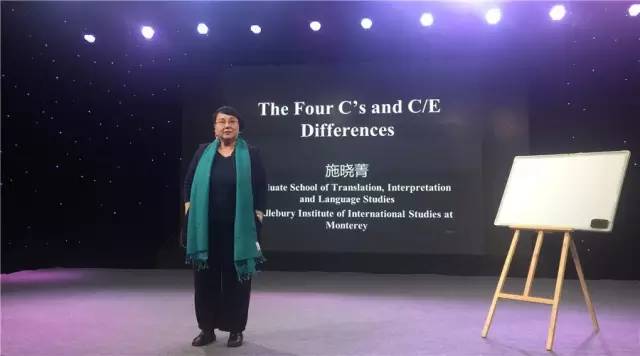她是中国翻译界的“混血女神”,
自幼通晓中、英、法三种语言,
职业履历更是充满传奇色彩。
她在国际顶级翻译学院担任导师,
并长期致力于国家翻译人才培养与发展,
在业界颇具影响力。

2017年,施晓菁女士应邀加入【译堂课】,
开启国内首个顶级“翻译公开课”。
学习本期课程,你将:
领会各文本翻译通用的4C's方法论;
掌握语感与技巧并用的翻译处理方法;
感悟英文“火车”与中文“扇子”的经典妙喻;
重新认知中英语言差异、语言转换与翻译。
(建议在WiFi状态下观看)
主题:从中英语言差异重新认知翻译
Lesson 1. The Fwww.58yuanyou.comour C's and C/E Differences
导师:施晓菁
美国明德大学蒙特雷国际研究学院高级翻译与语言教育学院副教授、英/中项目主管
联合国译员
国际会议口译协会 (AIIC)成员
原《今日中国》杂志社法文翻译、英文翻译及审校
内容精要
The 4Cs
什么是4Cs?
Collocation 搭配
Connotation 含义
Cohesion 衔接
Coherence 连贯
Collocation and Connotationare about WORD CHOICE.
Cohesion and Coherenceare about INNER LOGIC.
They determine using the right word for the specific context.
Texts have a number of different functions
Expressive function 表达功能
Informative function 信息功能
Vocative function 呼唤功能
These functions are put into operation through different text types
Narrative 叙述,叙事
Deive 描述
Persuasive 说服
Polemical/argumentative 论证
Different text types have different discourses (“connected utterances”).
Different languages have different ways of expressing these discourses.
the 4 Cs
Language structures
The 4 Cs apply to all text types, in differing and varying degrees.
e.g. Deive/narrative texts may need closer attention to collocation and connotation to convey vivid images and individual style.
Persuasive/polemical texts need more attention to connotation, cohesion and coherence to explain a position or argument, and to persuade.
Academic/scientific texts need more attention to correct usage and coherence for factual precision and clarity of logic.
Brief review of main translation techniques
Different languages have different structures.
Translation techniques have evolved to deal with these differences.The process of translation is the intuitive/conscious application of these techniques.
Translation techniques
npacking 解包袱法 (main idea, semantic / logical links between words / phrases, assocwww.58yuanyou.comiated meanings, etc.)
conversion 词性转换
amplification, omission, repetition 增减重复法
negation 反面着笔法(正话反译,反话正译)
division, combination, shifting 分合移位法
Some fundamental differences
Phonetic and writing systems (语音/书写系统)
Words meanings (语义 Word matches)
Grammar - Inflected v.s non-inflected (屈折语/非屈折语)
Syntax--high context (parataxis) v.s low context (hypotaxis) (意合语/形合语)
Word order -- left-branching v.s right-branching
Discourse -- Deductive v.s inductive (推论/归纳 ;由大到小/由小到大)
English and Chinese:
the train and the fan
Chinese is a left-branching language.
English is a right-branching language.
English: formal logical links, grammatical markers, rigid syntactic structure and order
Train -- with engine and carriages, closely and clearly linked by markers and logic, in a straight line.
Chinese: implied logical links, few grammatical markers, looser syntactic structure and order
Fan -- with spokes linked to a central idea, andwww.58yuanyou.com to each other horizontally.
Example of a “Train”
The woman, who declined to be identified, said she was told by a senior monk that most of his young colleagues were still asleep because they had stayed up to watch the World Cup games which can go on well past midnight.
"Train" dissected
Engine (subject): “the woman”
“Carriages": 1st subordinate attributive clause:www.58yuanyou.com “who declined to be identified”
2ndsubordinate noun clause: “that most…”
3rd subordinate adverbial clause of reason: “because…”
4th subordinate attributive clause: “which can go on…”
There is a priority in the ordering of components.
Example of a "fan"
中国政府统揽全局,面向新世纪,作出了实施西部大开发战略,加快中西部发展的大决策。这对于拓展国民经济持续增长空间、促进地区之间协调发展,具有十分重要的意义,必将加快中国现代化进程,为世界和平与发展作出积极贡献。
"Train" dissected
The central ideahere is :开发战略 will have very positive effects, not only on 大西北 but also in many other areas and aspects.
This is like the hub of the fan.
The other sentences/clauses cluster around interconnected by general meaning, yet without explicit grammatical links, and sometimes without even clear logical links.
"Train" dissected (cont'd)
中国政府is the subject of 作出...开发战略
What’s the relationship between 中国政府and 面向新世纪? On a par with 统揽全局or a separate phrase of time?What’s the subject of 加快…重大决策?Still 中国政府 or 战略?
What does 这allude to:战略,决策or the “action” of deciding?
What is the subject of …必将加快…? 这(which is already ambiguous) or 协调发展?
What is the subject of 积极贡献?中国现代化进程 or 协调发展 or 这?
"Train" dissected (contd)
All these components, like the spokes of a fan, are linked by meaningto the central theme, but their grammatical links are implied, or ambiguous, and so meaning links are also ambiguous. The priority is not always clear.
What to Check for...
Self-check
Word level: spelling, punctuation
Agreements: singular/plural, subject and verb
Consistency of pronouns
Verb tenses
Prepositions
Articles
Conclusion
Turning a “train into a fan” or vice versa is complex and often difficult.
Translation is a process, needing repeated review, analysis and examination on many levels, and a conscious use of techniques.
Extra-linguistic knowledge is essential
– a thorough understanding of both the SL’s and TL’s culture and history, sensitivities, biases, etc.







